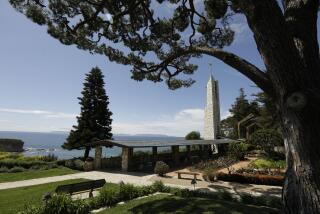Offshore Volcano Offers an Ocean of Possibilities
- Share via
GRANTS PASS, Ore. — A Navy submarine tracking system has tipped off scientists to what looks like an undersea volcano erupting 95 miles off the coast of Oregon.
The eruption offers a rare opportunity for scientists to see how the bottom of the ocean is formed--while it’s happening--and to study an entire ecosystem of microbes living under the sea floor.
The National Oceanic and Atmospheric Administration’s Pacific Marine Environmental Laboratory in Newport began hearing a series of very small earthquakes on Feb. 29 along the Gorda Ridge off Cape Blanco at a depth of two miles, said geophysicist Christopher Fox.
The activity resembles a volcanic eruption the lab confirmed in 1993 along the Juan de Fuca Ridge about 240 miles west of Astoria, after hearing it on a modified version of the Navy’s Sound Surveillance System, or SOSUS.
The system, consisting of a network of underwater microphones, was developed to track Soviet submarines.
The lab dispatched the NOAA research vessel McArthur to the site from Seattle.
The crew spent 2 1/2 days collecting temperature and chemistry readings and water samples on a huge plume of hydrothermic fluid that spewed out of the ocean’s floor before bad weather March 12 forced it to head back to port.
The lab hopes to get the Oregon State University research ship Wecoma, based in Newport, to return to the site in early April. Equipped with a towed array of underwater video and still cameras, it could confirm whether lava was spewed onto the sea floor.
The event represents a rare opportunity to study a natural process while it is happening, instead of trying to reconstruct it after the fact, said Robert W. Embley, a geophysicist at the lab.
The Gorda Ridge is part of the 40,000 miles of mid-ocean ridges that span the globe. Lava oozing out of the ridges forms the ocean floor.
“The sea floor is stretching all the time,” Embley said. “When it stretches enough, it will eventually crack.”
When it cracks, it can spew out a vast volume of hot water loaded with minerals, such as iron and manganese, as well as microbes that live in the porous volcanic rock on the bottom of the ocean.
If a volcanic eruption occurred, it would be an oozing of lava, not the explosive blast of a Mt. St. Helens, Fox said. It doesn’t pose any danger to shipping or coastal areas.
Tracking a temperature variation of just a quarter-degree, the McArthur was able to map the megaplume at six miles in diameter, said Edward Baker, the NOAA scientist on board the ship.
In addition, scientists collected samples of bacteria that live in extremely hot water. They appear to be the same kind found underneath the sea floor.
“We’re almost certain there has been some sort of magmatic activity either within the [Earth’s] crust or all the way to the sea floor,” Baker said.
NOAA has found three similar occurrences since stumbling upon one in 1986 along the Juan de Fuca Ridge. The 1993 eruption detected by the lab coincidentally occurred just before a planned expedition to the area.
The 1993 eruption disclosed the presence of an entire ecosystem of primitive bacteria and viruses living in the volcanic rock of the sea floor. The genetic material in the bacteria could be 1 billion years old, Fox said.
The bacteria live on hydrogen sulfide gas associated with volcanic activity. When there is a hydrothermal event, they reproduce rapidly and are dispersed throughout the water column, Embley said.
“Some people believe life on Earth originated like this,” Baker said.
For more information, check updates on the World Wide Web. The address is: https://www.pmel.noaa.gov/vents/eruption.html






